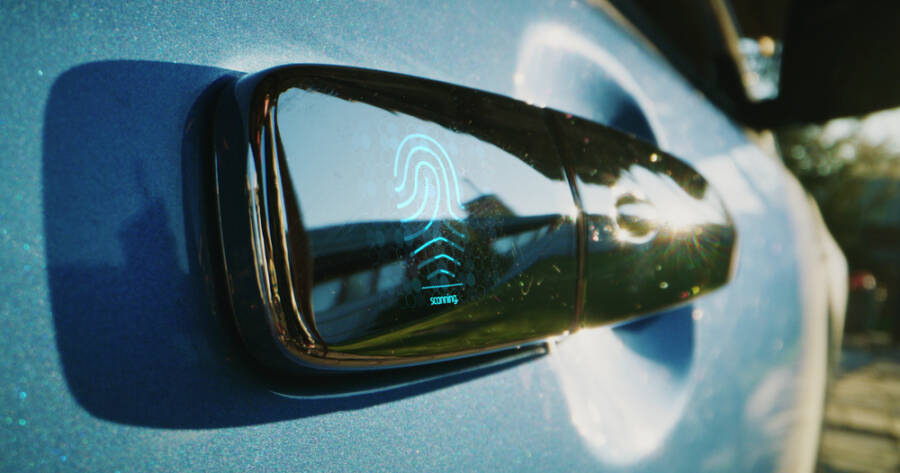Biometric technology is moving rapidly into the automotive world, promising a future where fingerprints, facial recognition, and even voice authentication could replace traditional keys. As automakers explore smarter, more secure ways to control vehicle access, biometric systems offer both convenience and stronger protection against theft. Yet questions remain about reliability, privacy, and real-world performance. With innovation accelerating, the shift toward keyless, identity-based entry is becoming increasingly difficult to ignore.
The Rise of Biometrics in Vehicles
Biometrics rely on physical traits—like fingerprints, facial recognition, and even voice patterns—to verify identity. In the automotive world, manufacturers have begun experimenting with these features to improve convenience and prevent theft.
High-end vehicles already offer biometric options, typically starting with fingerprint recognition on the start button or door handle. Some concepts and select production models even include facial recognition to unlock the vehicle or adjust driver settings. These systems aim to make the driving experience more personal, streamlined, and secure.
How Biometrics Are Being Used Today
While we haven’t completely said goodbye to car keys, several brands have taken steps toward making that possible. For instance, some vehicles allow you to use a smartphone app in place of a key fob. Combined with fingerprint scanners or facial ID, this turns your phone—and your body—into your access pass.
Certain models use interior cameras to detect the registered driver. Once detected, the car adjusts mirrors, seating, and temperature to the user’s preferences. This is often paired with two-factor identification, which means biometrics complement rather than replace the car key entirely.
Voice control is also gaining traction. Beyond hands-free calling or navigation, some systems now allow owners to start their vehicle or unlock the doors with voice commands, assuming the system recognizes the speaker.
The Pros and Pitfalls of Biometric Security
There are clear benefits to using biometric systems in cars. They reduce the risk of losing your keys or having them stolen. Biometric systems also make it harder for someone else to impersonate you. In cases where cars are shared between family members or coworkers, these tools can speed up the transition between users by instantly adjusting preferences.
However, there are still challenges to overcome. Biometric data, once stolen, cannot be changed like a password or PIN. This raises questions about data storage and security. Many manufacturers now store this information in encrypted form inside the vehicle itself, rather than in the cloud, to prevent remote hacking.
Another concern is reliability. A wet fingerprint or poor lighting can interfere with recognition. If your biometric sensor fails or your smartphone dies, you’ll need a backup—meaning keys may not disappear entirely anytime soon.
Is the Industry Ready to Go Keyless?
The shift toward biometric-only vehicle access is not just about technology—it’s also about trust. Automakers must ensure that these systems are fast, reliable, and secure enough for everyday use. As of now, most companies treat biometric tech as a supplement to traditional methods, not a full replacement.
Some brands are developing solutions that merge biometric and digital access. For example, digital keys stored in your smartphone can be shared with others electronically. Combine that with a fingerprint scan, and you get both convenience and a second layer of security.
Government regulations and insurance providers may also influence the pace of change. Any widespread shift away from mechanical keys would need to address theft protection standards and liability questions. That said, as smartphone-based access becomes more common, full biometric integration seems more realistic with each passing year.
What’s Next for Biometric Cars?
Experts agree that biometrics will likely continue to grow as part of a broader trend toward digital access and personalization. In the next few years, we may see broader use of facial recognition systems, both inside and outside the car. Startups and tech giants alike are working on combining multiple forms of biometric input to minimize error and increase ease of use.
Some automakers are also looking into heartbeat recognition and retina scans, especially for luxury vehicles. These ideas may sound futuristic now, but as sensors become cheaper and more accurate, they could soon reach a wider market.
The Key to the Future
Biometrics are steadily carving out a place in the automotive world, but they haven’t yet made car keys obsolete. For now, most systems are designed to enhance convenience rather than replace traditional access entirely.
As technology continues to evolve—and as trust grows in its accuracy and safety—biometric access may well become the new standard for vehicle security in the years ahead.




